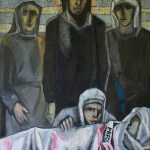

The Umm El-Fahem Art Gallery is pleased to announce the opening of “Manifestations of Letter: Text in Contemporary Palestinian Art,” on March 22. The exhibition, which will continue until May 24, 2014, will include works of art by a wide spectrum of Palestinian artists from Jerusalem, the West Bank, Gaza Strip and inside the Green Line: Abed Abdi; Asad Azi; Anisa Ashkar; Basel el-Maqosui; Bashar Alhroub; Farid Abu Shakra; Khader Oshah; Majed Shala; May Murad; Nasrin Abu Baker; Ra’fat As’ad; Sharif Sarhan, and Tayseer Barakat, in addition to a joint project by the Egyptian photographer Adel Wassily and Maliha Maslamani. A number of Palestinian artists will be present at the exhibition opening, which will take place on March 22 at 13:00 at the Umm El-Fahem Gallery in Umm El-Fahem.
According to the exhibition’s curator, Maliha Malamani: “A need exists to examine and reflect upon the accumulative textual and visual expressions in Palestine since the Nakba and until the present time — a need our exhibition comes to satisfy. The script has been overwhelmingly present in the Palestinian fine arts in different areas; whether in the form of poetry, short text messages, words, or alphabetical calligraphy, the script has constituted the core of the artistic work, or has formed an integral part of the totality of the visual narrative. This significant presence of the text in Palestinian art is due to the fact that text is derived from language, place and culture. Over the centuries, the Arabic language has gained a special and essential significance among Arabs.
With regards to the works participating in this exhibition, ‘text’ does not mean calligraphy only; neither is the exhibition reduced to works that elaborate the aesthetic aspects of Arabic calligraphy and language. Calligraphy is only a part –and not the whole — of the textual composition of Palestinians, though undoubtedly, it constitutes a substantial part of their cultural significance, as well as their visual significance and identity-related aesthetics. Nevertheless, many texts in Palestinian artworks have their origins in visual configurations that are quite far from calligraphy and its aesthetical aspects.
This diversity in the use of textual elements and forms that can be observed in a variety of contemporary artworks, invokes in the mind of the reader many and complex semantic prospects. The text draws its aesthetic and artistic aspects from its mere presence in the artwork, either as a major theme within the artwork, or as an essential element in its composition.
Palestinian literature, and Arabic literature in general, are the primary material for the Palestinian fine arts. Therefore, it is impossible to read the Palestinian artworks without any knowledge of the legacy of Arab literature, and Palestinian literature in particular. For Palestinian arts in general, Arab and Palestinian literature do not only form a source of textual forms. Thus, by primary material we also mean the concepts and prospects with respect to identity, as well as the political and cultural issues such as the Nakba, refuge, exile, resistance, nation, the representation of the Palestinian woman, and other basic themes in Palestinian literature that continue to constitute the major themes of Palestinian artworks”.
Please note that an in-depth study on the implications of the text in the Palestinian art, elaborated by the exhibition curator, Maliha Maslamani, will be included in the exhibition’s catalogue to be produced by the Umm El-Fahem Gallery within the next few months.
{flike}




















